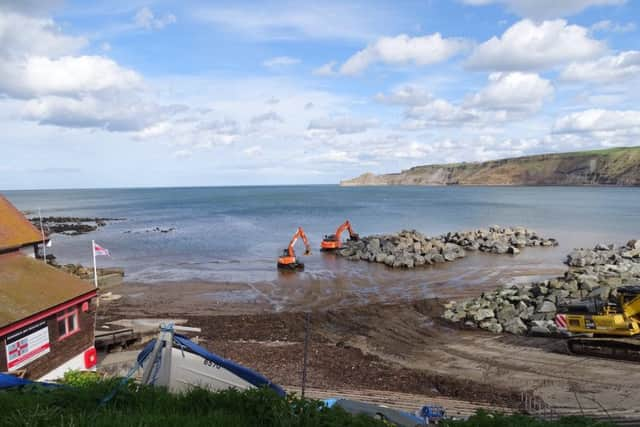Midnight work to protect idyllic village from encroaching tides
The fishing village of Runswick Bay, near Whitby, has long faced warnings it may have to be abandoned amidst a constant threat of landslips and erosion.
Now, having secured £1.5m of funding, backed by £100,000 from tenacious villagers, midnight work is underway to place new ‘rock armour’ defences.
Advertisement
Hide AdAdvertisement
Hide AdAnd, after all best laid plans were waylaid by ‘the beast from the east’, a mad scramble is underway to place the stone in time to the turning tides, and ahead of the start of the tourist season.


“The village relies on being protected by a very old sea wall built in 1901, which was in a dangerous state of repair, undermined by the sea,” said Dennis Whiteley, chairman of the Runswick Bay Coastal Protection Trust. “This is a big investment to protect Runswick Bay for the next 100 years.
“It’s an idyllic little village, referred to as the jewel in the crown of the national park,” he added. “It’s certainly worth preserving.
“They’ve been working through the night, to keep in with the tides. But I don’t know anyone who has objected to that - everybody is just happy to see it progressing.”
Advertisement
Hide AdAdvertisement
Hide AdThe project, funded by the Department for Environment, Food and Rural Affairs (DEFRA), aims to protect Runswick Bay’s 96 properties by preventing waves coming over the sea walls.
The project involves new concrete protection in front of the sea wall.
There will be new access steps, repairs to the sandstone walls and the creation of 150 small rock pools which will become a habitat for sea life.
It’s faced weeks of uncertainty and delays, as the barge bringing in rock armour, blocks of stone imported from Norway, faced a battering in March storms and was forced to take shelter off the coast in Holland. And because of the tides, it can only be placed in the middle of the night.
Advertisement
Hide AdAdvertisement
Hide Ad“Mother Nature has played havoc with our original plans,” adds Coun Mike Cockerill, Scarborough Council’s cabinet member for major projects. “And the entire project has very much been dictated by tides. It’s a case of trying to get the stone as near to the working area as possible.
“The main thing is the stone is there. Work is progressing, more or less on plan. Everybody is working towards ensuring it is complete so that it doesn’t interfere with the tourist season.”